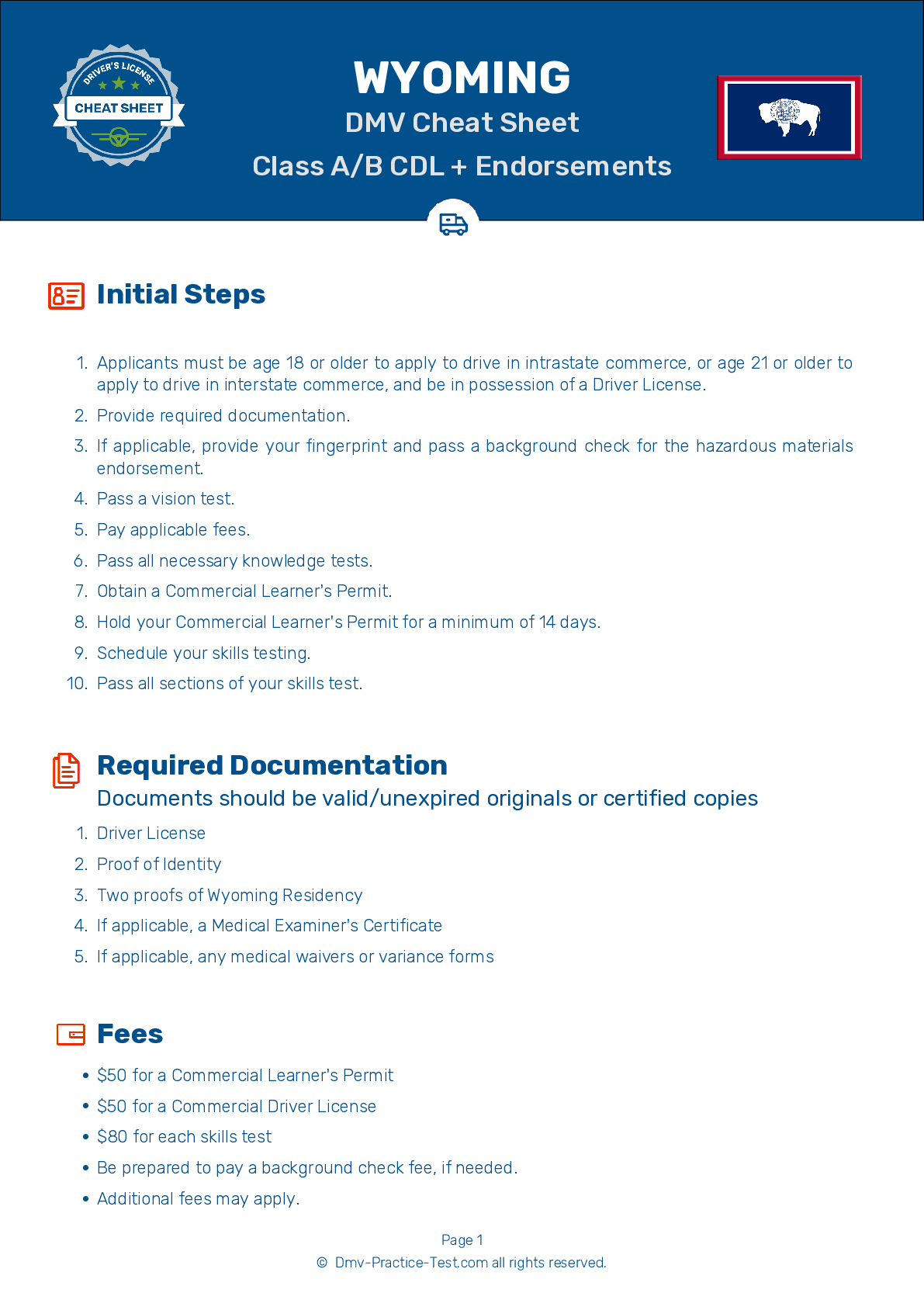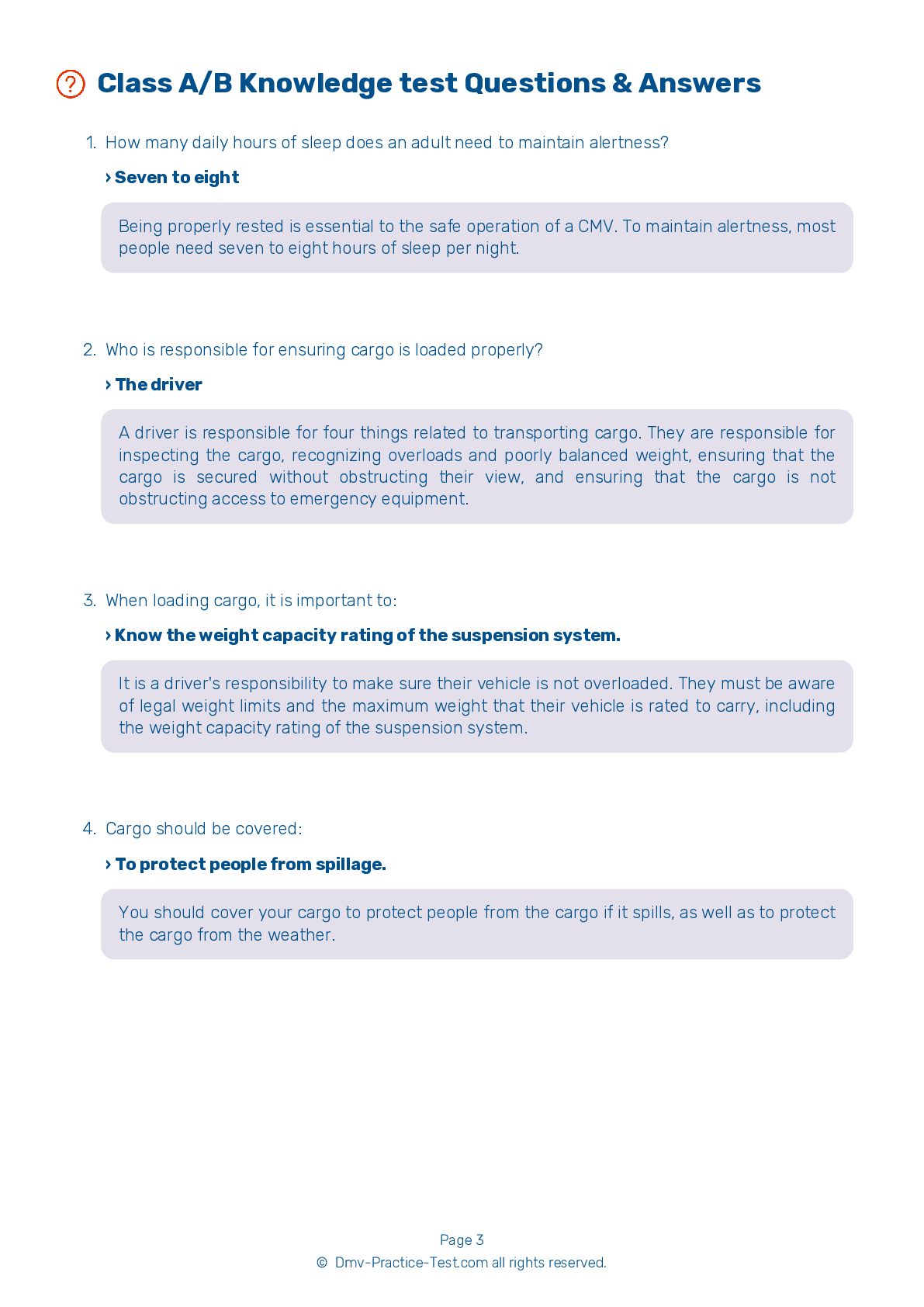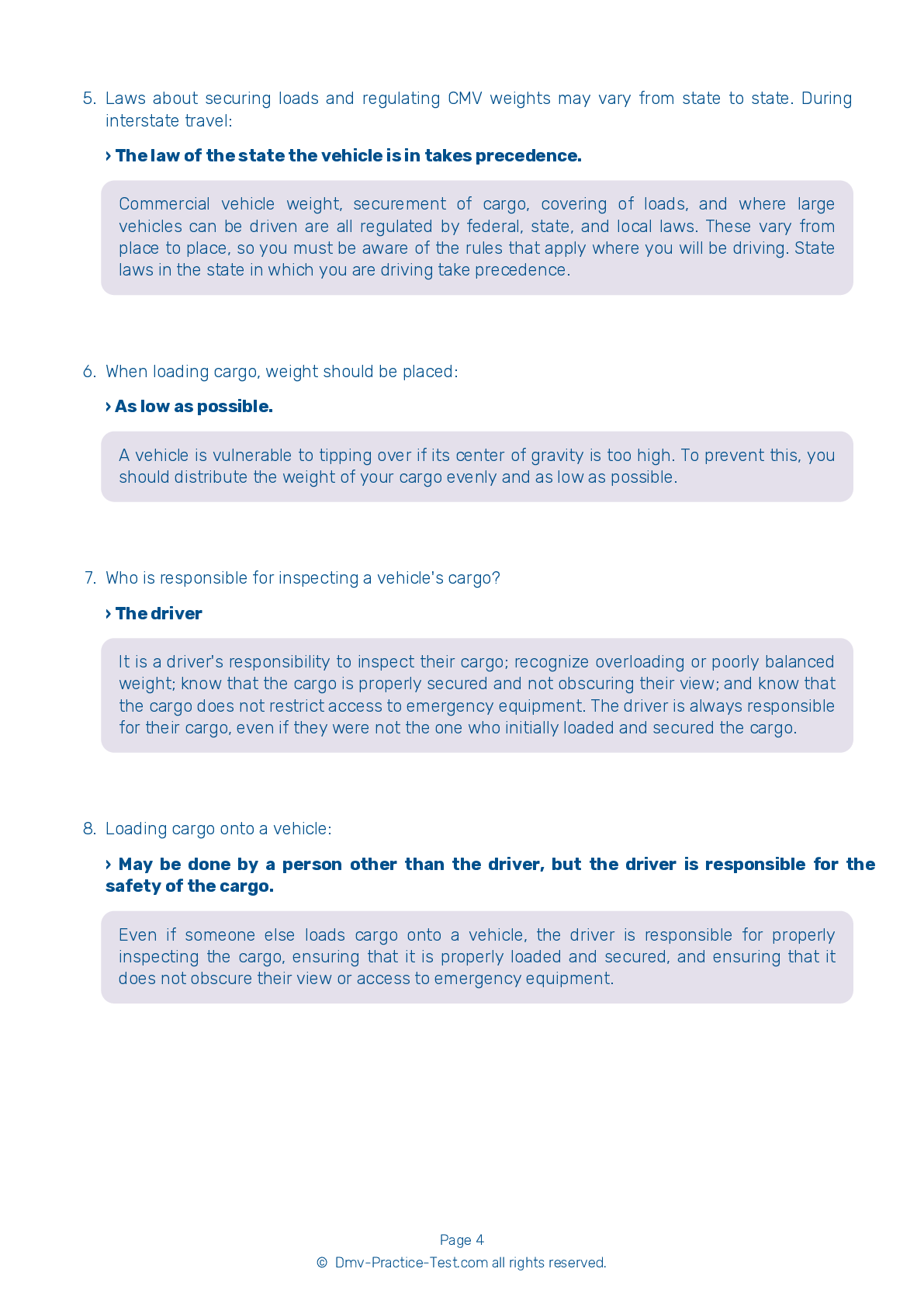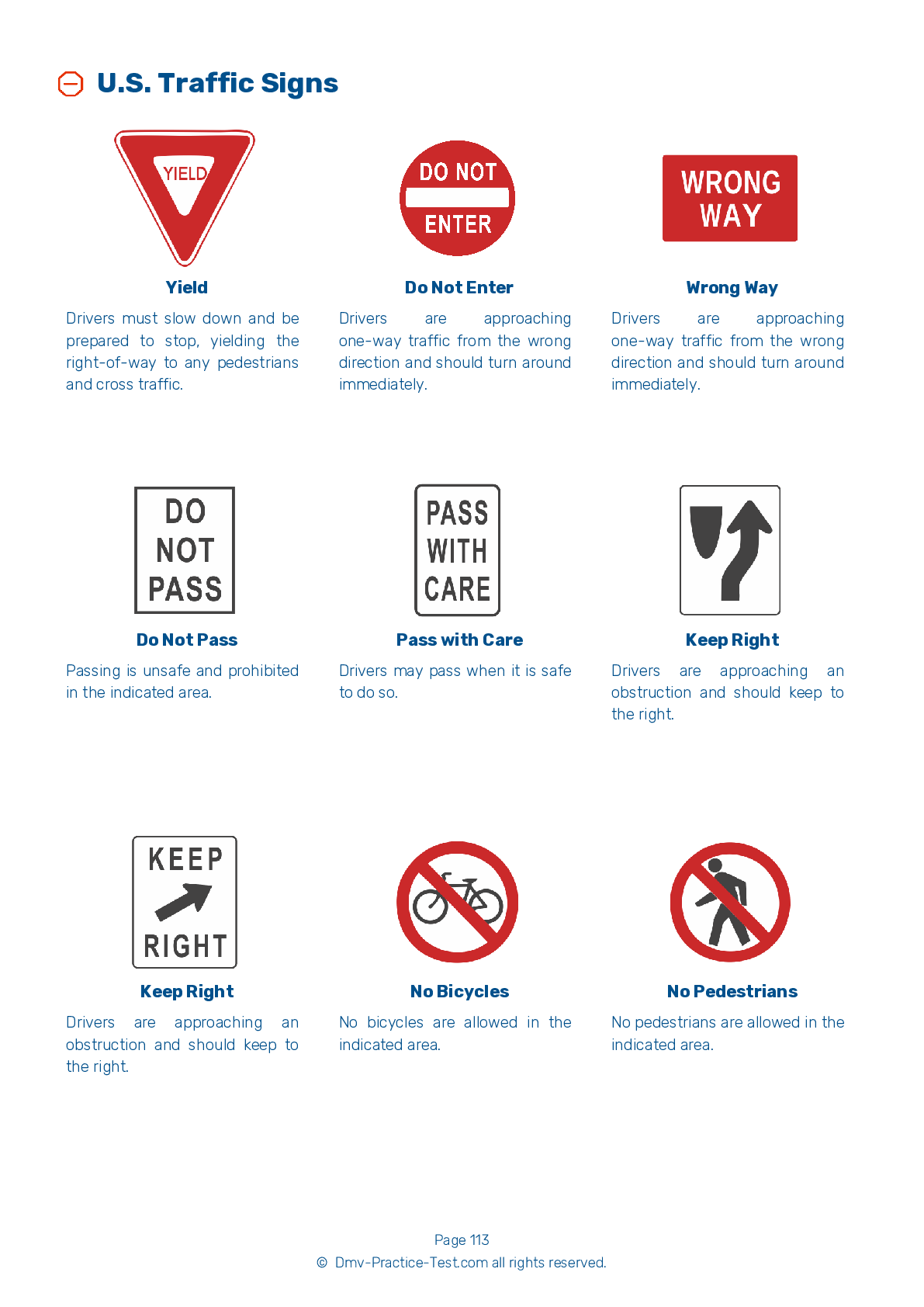Knowledge Test Class B #2
Class B Driving Test | Wyoming 2025 #2 Page 2 of 7
Train for FREE online with our Wyoming class B license test. The official exam test consists of several obligatory parts, with all of them checking your knowledge of different blocks of road rules. If you need to obtain a WY CDL class B permit in 2025, practice as much as possible. Free sample tests published on our website will help you check and improve your knowledge and boost your grades. Please bear in mind that CDL class B requirements may vary from state to state.
50
40
20
8 . In a dual air brake system, air pressure should build from 85 to 100 psi within ____ seconds.
When inspecting a vehicle with a dual air brake system, you should wait for air pressure to build from 85 to 100 psi in both the primary and secondary systems. This should take about 45 seconds.
9 . A jogger wearing a stereo headset:
Be careful around pedestrians, joggers, and cyclists who are wearing headphones. They may be unable to hear your vehicle approaching and may do dangerous things because they do not know you are there.
10 . Which of the following surfaces provides the least amount of traction?
Dry pavement
Be especially cautious when driving on ice that has begun to melt. Ice that is wet is much more slippery than ice that is dry.
11 . If you plan to slow down, you can warn drivers behind you by:
Putting your hand out the driver's side window and waving.
Before slowing down, it is a good idea to flash your brake lights by lightly tapping your brake pedal a few times. This will warn drivers behind you of your plans to slow down.
12 . How many daily hours of sleep does an adult need to maintain alertness?
Four to five
Being properly rested is essential to the safe operation of a CMV. To maintain alertness, most people need seven to eight hours of sleep per night.
13 . If other vehicles are having a difficult time getting around your truck on a road with two or more lanes, you should:
You should stay in the right lane of a multilane road if your vehicle is being slowed down by a heavy load. Allow other vehicles to pass your truck using the left lane.
14 . States verify that a CDL or CLP driver has only one such license by:
Looking through the driver's wallet.
All U.S. states share information about CDL and CLP licenses in a computerized database. If you apply for a license in one state, a state will check this database to verify that you do not already have one such license in another state.
2025 Wyoming | Frequently Asked Questions
A CDL Class B license in Wyoming qualifies the holder to operate vehicles with a Gross Vehicle Weight Rating (GVWR) of 26,001 pounds or more, or towing vehicles not exceeding 10,000 pounds GVWR. This includes straight trucks, large buses, segmented buses, and trucks towing smaller vehicles within the weight limit. You must pass a written and skills test to obtain it.
A Class B CDL license in Wyoming allows the holder to operate single vehicles with a Gross Vehicle Weight Rating (GVWR) of 26,001 pounds or more, or tow vehicles not exceeding 10,000 pounds GVWR. This includes straight trucks, large passenger buses, segmented buses, dump trucks with small trailers, and any truck towing a smaller vehicle within the weight limit.
To acquire a Class B CDL license in Wyoming, you must be at least 18 years old (21 for interstate driving), possess a valid Wyoming driver's license, pass a vision test, and complete a medical examination. You also need to pass the Wyoming Commercial Driver License knowledge test and the skills test, which includes a pre-trip vehicle inspection, basic vehicle control, and on-road driving.
To qualify for a Class B CDL license in Wyoming, you must be at least 18 years old for intrastate transport (within Wyoming only). However, federal regulations require drivers to be at least 21 years old to drive commercial vehicles across state lines, carry hazardous materials, or transport interstate freight within the state.
Specific endorsements aren't necessary for a Class B CDL license but can be added based on the type of vehicle you plan to drive or cargo you plan to carry. These include endorsements for passenger vehicles (P), school buses (S), and tank vehicles (N). Each endorsement requires additional testing.
The Class B CDL skills assessment in Wyoming includes three parts: pre-trip vehicle inspection, basic vehicle control, and on-road driving test. You'll need to demonstrate knowledge of your vehicle's parts and their function, show you can control the vehicle (including backing up), and safely drive in various traffic situations.
Yes, Class B CDL license holders in Wyoming are limited to operating vehicles that fall under the Class B category, which includes single or combination vehicles not exceeding 26,000 pounds. They can't operate Class A vehicles unless they upgrade their license. Also, they can't drive vehicles requiring specific endorsements (like passenger or school bus) without passing additional tests.
The written Class B CDL test in Wyoming is offered only in English, as per Federal Motor Carrier Safety Administration (FMCSA) regulations. This is because English language proficiency is considered necessary for safety reasons, including understanding traffic signs, communicating with law enforcement, and reading shipping papers.
Yes, you can request test accommodations for the Class B CDL written exam in Wyoming if you have a disability. The Wyoming Department of Transportation provides reasonable accommodations in accordance with the Americans with Disabilities Act. You'll need to contact them directly to discuss your specific needs and make arrangements.
If you don't pass the Class B CDL written test in Wyoming on your first attempt, you can retake it. However, you must wait at least one day before retesting. If you fail three times, you'll be required to wait 30 days before taking the test again. Remember, each attempt may require a separate testing fee.



